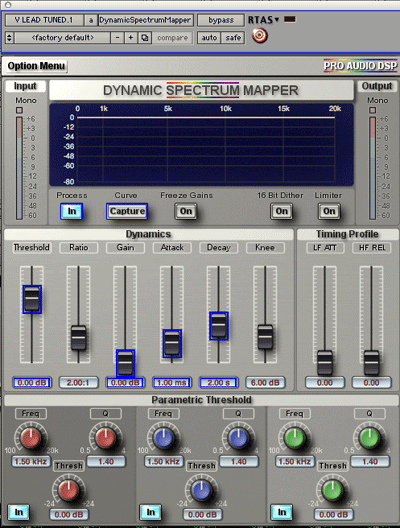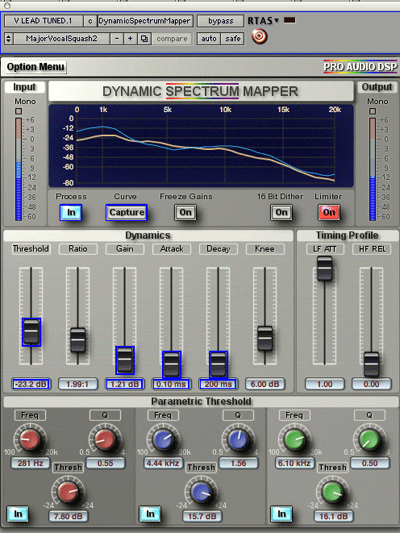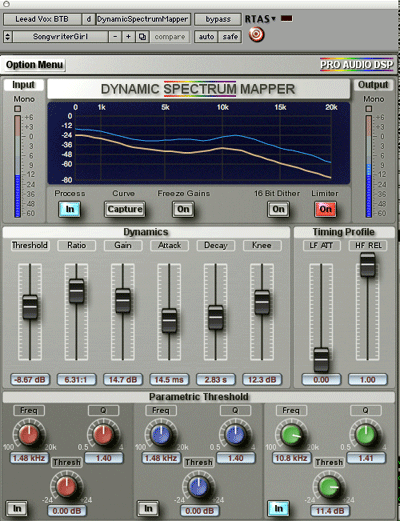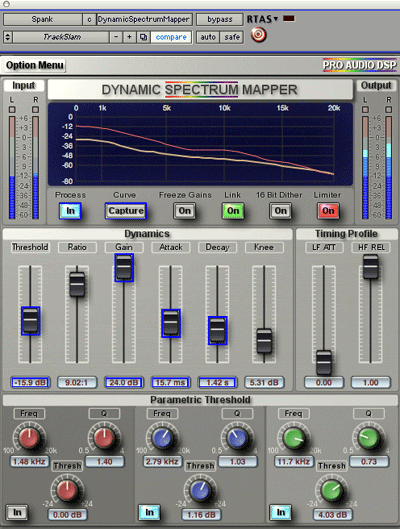With Comments By Producer David Gamson
|
Pro Audio DSP Dynamic Spectrum Mapper
by Barry Rudolph
With Comments By Producer David Gamson |
|
The Dynamic Spectrum Mapper plug-in's GUI, at first glance, looks like any other multi-band mastering limiter plug-in--IT IS NOT even close. Running as a VST, RTAS or AU plug-in in Mac or PC DAWs, conceptually, DSM is far removed from all adaptive spectral and dynamic processors currently available.
DSM uses an FFT-based process (that's Fast Fourier Transform) to split the audio program into many weighted frequency bands each of which undergoes gain modification specifically predicated upon the band's effective power. The bands are distributed in a linear fashion across the entire audio band so the concentration of bands declines as frequency goes down. After compression, the bands are recombined for output to a limiter stage used to control peak levels.


Default DSM Setup Ready To Do A Capture
Capture Process
The Dynamic Spectrum Mapper (as the name implies) is unique because it has the ability to "capture" or analyze a portion of or the entire audio program and create a map--a spectral knowledge database history of levels vs. frequencies over time. This datum or characterization of an audio program's unique frequency spectrum and dynamic ebb and flow is displayed as a horizontally drawn yellow curve on the plug-in's GUI and is used as a threshold baseline or target level for further dynamic alteration.
This baseline represents stasis--where the output of the plug-in is equal to the input signal. All gain reduction processing begins as the program crosses over this curve's level. Before Capture and if the Threshold fader is at 0dB, the yellow Threshold line will be a straight line from 0Hz to 20kHz. A red line across the same chart shows a live spectral/level reading of the music track as it plays.
While Capture is active, the previously straight yellow threshold line will copy this red line's instantaneous shape for exactly as long as the Capture button is held, an average threshold will be calculated. You could also capture until the song's end resulting in an averaged threshold curve for the whole song. But that is not the best use of this remarkable feature.
If a capture is done just at the quietest moment in the song, its level and frequency make up will be used as a baseline threshold for entire song. When the song increases in level and exceeds this threshold, compression will occur following the settings of the GUI's compressor controls.
Overall compression is changed manually with the Threshold control that raises or lowers the entire length of this curve keeping its shape intact--indicating the proportional change in all the underlying frequency bands' individual thresholds and therefore their compression amounts.
Because dynamic manipulation is carried out on many individual bands of frequencies each unique in level and frequency content, natural (or unnatural) sounding compression levels can be obtained over vast dynamic ranges. In addition, each band's compression process is free of interaction from the other bands.
To contrast a typical multi-band compressor, each band contributes (more or less) to the aggregate level of the program but each band's compression amount is fixed and operates in isolation without any reference to the other bands' gain reduction activities.
When any band in DSM exceeds threshold and starts gain reduction, its level (and energy) is reduced in relation to the other bands according to the spectral differences. And also unlike multi-band units, if one or more of the bands receives no gain reduction, that band(s)' audio remains bit-for-bit the same as the input signal when all the bands are recombined for output.
Lastly, DSM has none of the typical artifacts of either multi-band or conventional limiter/compressors. The magnitude of the artifacts from DSM is proportional to the difference between bands only--there are no phase issues, ringing filters or crossover distortion endemic to multi-band units.
While using DSM, momentary and heavy compression occurring in the low frequency bands will not "punch" holes in any other parts of the spectrum--an effect most noticeable in the high frequencies.
| Baron Jean Baptiste Joseph Fourier 1768-1830
What Is A Fast Fourier Transform? | |
|
Works Like Any Compressor
With the 'character' captured in the form of frequency-based threshold level baseline, users of DSM are now free to further modify gain reduction for artistic and/or corrective reasons using familiar compressor controls such as the aforementioned Threshold plus Ratio, Make Up Gain, Attack, Decay or Release, and a soft Knee control. Soft Knee control sets the level in dB below the compressor's active threshold at which it starts pre-compressing the signal.
There are also three Parametric Threshold controls for further shaping gain reduction in three different frequency areas each adjustable from 100Hz to 20kHz. These controls have Frequency, Q, +/-24dB boost/cut controls and In/Out buttons for assessing their effect. The plug-in also has a Low Frequency Attack adjustment that increases the attack time only in the low frequency bands and a High Frequency Release Time fader that decreases release time only in the high frequency bands.
DSM stores the captured character database along with all parameter settings in a preset so it is available to be used elsewhere. You can use this feature to superimposed one program's frequency/dynamic character upon any other, entirely unrelated audio program.
In the Studio
As complex as it might seem initially to "wrap your brain around" DSM's concept, the GUI is simple to work. I'm a person who likes to know what every single control, parameter and option does so I'm a big reader of manuals. I would recommend reading Paul Frindle's manual to get the maximum use out of this software but, then again, it is not necessary to read it at all.
A good understanding of compressors and compression is helpful otherwise rely on the many presets to get you going in the beginning. Frindle has some Captures from Rock, Pop, Jazz and Classical productions that work very well to start with.
 |
| DSM Setup For Signature Rock Girl Sound |
I captured during a chorus--you must capture while audio is present--capturing while no audio plays produces a below -80dB threshold and is useless. I wanted the choruses to be still up in level and the verses loud too because she sang in a more whispery voice.
The signal chain was a Sonnox Five Band EQ, WAVES' API 2500 followed by DSM.
Check Fig. 1 for the DSM GUI setup
This vocal sound was extremely rich with absolutely every bit of subtle distortion and graininess produced by the mic, mic pre-amp, recording chain, editing, and the other plug-ins well heard. I could now hear all the very low level distortion that you do not usually notice on the raw vocal track--it sounded very clean--I thought.
With so much gain added, I could hear very well the headphone bleed, the leakage of the studio monitor speakers through the wall plus a few bad vocal edits I had to fix. This was amazing to me and even more striking was that it all worked so well for the song and within the track. The vocal sat very well in the track without much vocal riding required. It had a presence without being overly dominate or shrill as usually the case when using a strident EQ setting in an attempt "to cut" the track.
DSM For Smooth Vocals Too
 |
| More Subtle DSM Setup For Softer Girl Singer |
All my attempts before DSM with using a compressor/EQ/De-esser to help with these problems either made the problem worst or beat up the rest of the sound of the vocal too much. The producer, the artist and I favor a bright sound and were looking for a very clear and pristine vocal sound that sounds like the artist is telling her story quietly right into your ear. Unfortunately brightening and gaining up the vocal track to get this sound only made all my problems worst.
When set more subtly DSM worked super well in this situation--it was just as clean and clear as using no compressor. Check Fig. 2 for this DSM setup and you'll notice that the yellow threshold and live program line are a lot closer together meaning threshold is mostly at the actual level for low compression.
I found about half of my automation moves were not required at all and what changes I made were because of super loud breathing and radical changes in mic proximity. The bass build up during those proximity moments was ameliorated nicely within DSM without hard pumping. Yet the vocal took on a fatter and warmer sound than what I was getting with my usual and previously favorite compressor.
DSM On The Stereo Bus
 |
| DSM Setup For A Rock Track's Stereo Bus |
I set up and measured using Roger Nichols' Digital Inspector XL Meter plug set to K-14 on both chains at the same time and at the same moment in the track and found DSM to be louder, fuller and warmer sounding. By comparison, my previous chain sounded small, thin and cheesy.
Fig. 3 shows my DSM set up that was perfect for Pop songs where dynamics are not very important--actually I was looking for a relentless loud level from top to bottom here. So the adage: "It's not how loud you make it, but how you make it loud" could be the Pro Audio DSP DSM motto.
My good ol' 2-bus chain's limiter was set to not exceed 0.01dBfs while DSM, whose limiter does not have a similar control, consistently made 0.00 dBFS levels as measure on the RND meter. Both limiters produced no overs but I am concerned about a CD player's D/A converters interpreting a 0.00 dBFS level for consecutive samples as inter-peak distortion and then distorting. A conference with a proper mastering engineer will answer this one for me!
Pro Audio DSP states that the Limiter uses a saturation algorithm and does nothing until the output level reaches -1.0dB. At that point it starts to saturate gently up to around +5dB whereupon it will commence to start clipping. The limiter sounds great but I wish I had more control of its specific actions plus an indication of its instantaneous gain reduction.
DSM Is Like A New Girl Friend!
I am super impressed with the Pro Audio DSP Dynamic Spectral Mapper plug-in because it is super easy to use and sounds fantastic even when wound up loud. So far I've found it to excel for vocals and stereo buss processing in my Pop music mixing and I've been going to it first when searching for something fresh in dynamic processing.
Dynamic Spectral Mapper sells for £200 and is available from:
www.proaudiodsp.com/ where you can also try is a 21-day demo.
Check the video tutorials at: www.vimeo.com/2365432.
| David Gamson Comments On DSM | ||||||
|
|
|
||||
|
|
|